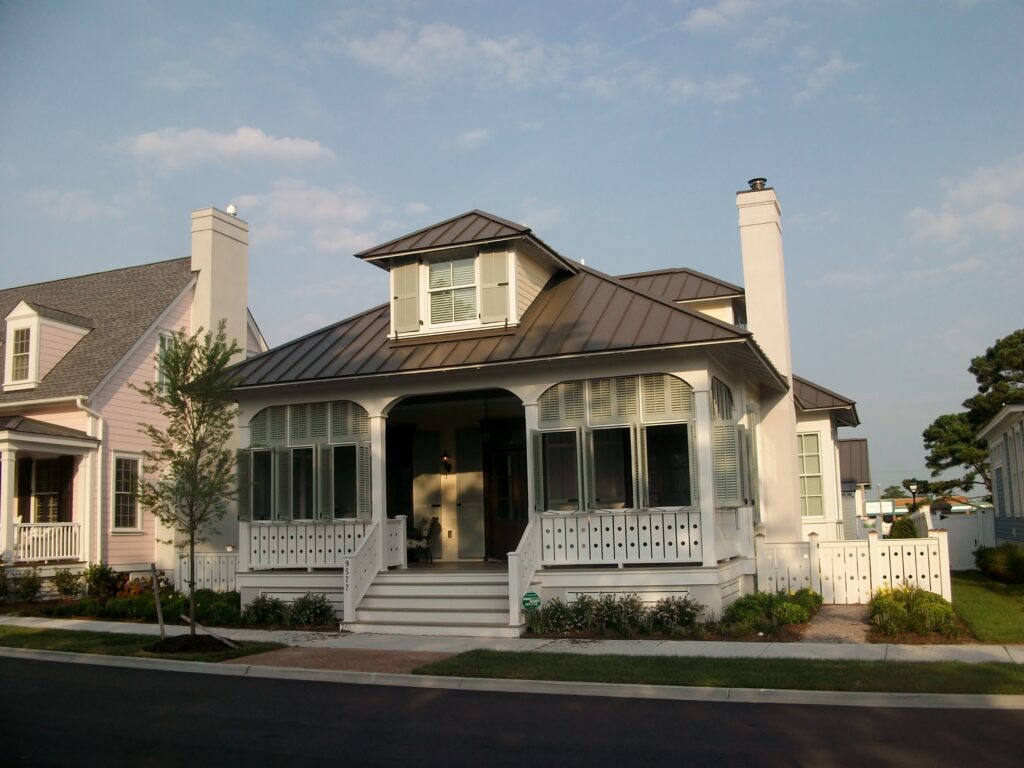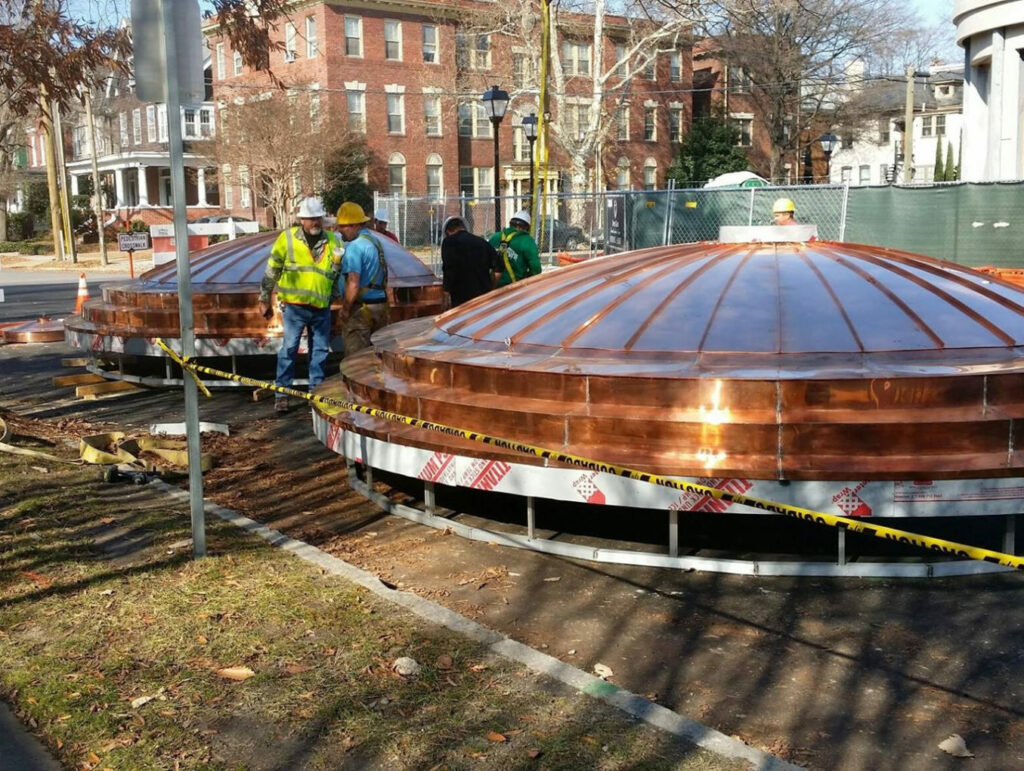Types of Slopes
Steep Slope
The following roof covering products are commonly used for steep-slope structures. The covering you select will determine the aesthetics and architectural style of your roof. It will also impact cost and durability. The Andrews Roofing Consulting Estimator (CE) will help you determine which type of roof covering best suits your needs.
Asphalt Shingles – are the most popular type of residential roofing material today and are among the most cost effective solutions for your roofing needs. Most asphalt shingles consist of a fiberglass mat, top-and-bottom layers of asphalt, and mineral granules. The most common and economical shingle in the market is the 3-tab shingle which is simply installed in a single-layer. A variation of the 3-tab shingle is the “architectural shingle,” which is manufactured in multiple layers. These roofing shingles are heavier than 3-tab shingles and therefore have an increased life cycle and performance rating. Both types of shingles are manufactured in many different colors.
Metal – roofing is on the leading edge of technology with a wide variety of finishes, designs, and colors. It provides not only exceptional durability and aesthetics, but also increased energy efficiency over traditional roofing products. Metal roofing is extremely fire resistant. It can also be designed to withstand extremely strong winds. Because of its high durability, metal roofing has low life cycle costs. Metal roofing can contain significant recycled content and is 100% recyclable at the end of its useful life.
Synthetic Roofing Tiles (Synthetic Slate, Shake, etc…) – are an innovative, high-performing roofing product with a look that is also very upscale and traditional. Synthetic roofing systems have an estimated material life cycle of from 40 to 60 years. The manufacturing process, utilization of recycled materials, weight/transportation costs, and product re-use all contribute to the sustainability of the product and for qualifying projects can even provide LEED points. Andrews Roofing is an expert installer of many high-end synthetic roofing products and understands the complexities and benefits of these premium roofing systems.
Wood Shingles & Shakes – are made from cedar, redwood, southern pine and other woods. Wood shingles are machine sawn. Shakes are handmade and rougher looking. A point to consider: some local building codes limit the use of wood shingles and shakes because of concerns about fire resistance. Many wood shingles and shakes have only Class C fire ratings or no ratings at all. However, Class A fire ratings are available for certain wood shingle products that incorporate a factory-applied, fire-resistant treatment.
Tile (clay or concrete) – is a durable roofing material. Mission and Spanish-style round-topped tiles are used widely in the Southwest and Florida, and flat styles also are available to create French and English looks. Tile is available in a variety of colors and finishes. Tile is heavy. If you are replacing another type of roof system with tile, you will need to verify that the structure can support the load.
Slate – is quarried in the United States in Vermont, New York, Pennsylvania and Virginia. It is available in different colors and grades, depending on its origin. Considered virtually indestructible it is more expensive than other roofing materials. In addition, its application requires special skill and experience. Many old homes, especially in the Northeast, are still protected by this long-lasting roofing material. Andrews Roofing employs experienced slate technicians who can install both new slate roofs or do the repairs that allow homeowners to extend the useful lives of these stately roofing systems.
Low Slope (Flat)
Low slope (flat) – Flat roofs are available in several design configurations: single ply membrane and built-up roofs (BUR). Each is described below. Your Andrews Roofing Consulting Estimator (CE) will assist you in making the best choice from among these flat roofing alternatives.
Single Ply – roofing materials include TPO, EPDM, PVC, and some modified bitumen membrane systems.
TPO (Thermo-Plastic Olephine) – is quickly becoming the standard for low slope roofing applications in the mid-Atlantic area. TPO is a white, highly reflective and durable single ply membrane. What makes TPO great is its ease of installation and its heat welded seams. Because of its reflectivity, it is a cool roof, exceeding current energy efficiency standards and is a US Department of Energy, Energy Star rated roofing system.
EPDM (Ethylene Propylene Diene Monomer) – is similar to TPO in the fact that it is a single ply membrane. However, EPDM is a rubber compound instead of plastic like TPO. EPDM has a strong reputation for durability. With properly taped seams and detailed flashings an EPDM roof can easily last 30 years. However, unlike TPO the seams are treated with adhesive making them vulnerable over the long term and will eventually require maintenance.
PVC – is a single ply membrane that is similar in appearance to TPO. The manner in which a PVC membrane is installed is very similar to that of the TPO roof described above. A PVC roofing system requires a slightly greater investment than that of a TPO roof.
Modified Bitumen – is perhaps the most common of residential low slope, single ply roofing systems. It consists of asphalt that has had modifiers added to it to give it plastic or rubber-like properties. Modified bitumen is installed in 3′ rolls, either torch applied using flame heat to melt the cap sheet to the base sheet(s) or self adhering using factory applied adhesives on the various components.
BUR (Built up Roof) – membranes have been in use in the U.S. for more than 100 years. These roof systems are commonly referred to as “tar and gravel” roofs. BUR systems generally are composed of alternating layers of bitumen and reinforcing fabrics that create a finished membrane. The bitumen typically used in BUR roof systems is asphalt, coal tar or cold-applied adhesive. The asphalt or coal tar is heated in a kettle and then applied by mop or mechanical spreader.
To go directly to what you are most interested in, please click below.
– Choosing the Right Roof Covering
– Roofing Terms You Should Know
– Protect Your Roof From Its Enemies
– FAQs
Residential Roofing
Residential Roofing
A residential building is one in which people live. To be considered residential in the state of Virginia the building must contain no more than 4 private living spaces.
Commercial Roofing
Commercial Roofing
A commercial building is used for the purpose of conducting business. This may include a multi-family residential structure as well. Some examples include buildings used for retail, office, warehouse, churches, and apartment complexes.
Industrial Roofing
Industrial Roofing
An industrial building is used to manufacture consumable goods. Churches may also be classified as industrial structures.
Rapid Rain Gutter Systems
Rapid Rain Gutter Systems
The key to the Rapid Rain Gutter System’s uniqueness is the AR5600 Technology that provides a large capacity system that doesn’t look large or bulky, but achieves high-volume control of water flow.
Our Brands
Website built & maintained by Bull & Company MediaWorks





